Impact of Sensory Marketing on Consumer Behavior: A Proposal
VerifiedAdded on 2023/04/23
|13
|3607
|113
Report
AI Summary
This research proposal aims to investigate the impact of sensory marketing on consumer behavior. It begins by defining the research problem, aims, objectives, and significance, focusing on how sensory marketing, as a theoretical concept, can be applied in the industry to influence customers. The literature review covers sensory marketing concepts, including visual, olfactory, auditory, tactile, and gustative marketing, and their respective impacts on consumer behavior, drawing from various studies and examples. The proposal also offers recommendations to improve sensory marketing strategies, such as creating positive environments and utilizing effective visual tools. Finally, it outlines the research design and methodology, opting for a descriptive approach and utilizing survey methods for data collection to understand consumer stimulants for marketing goods and services. Desklib provides access to this report and other student-contributed assignments.
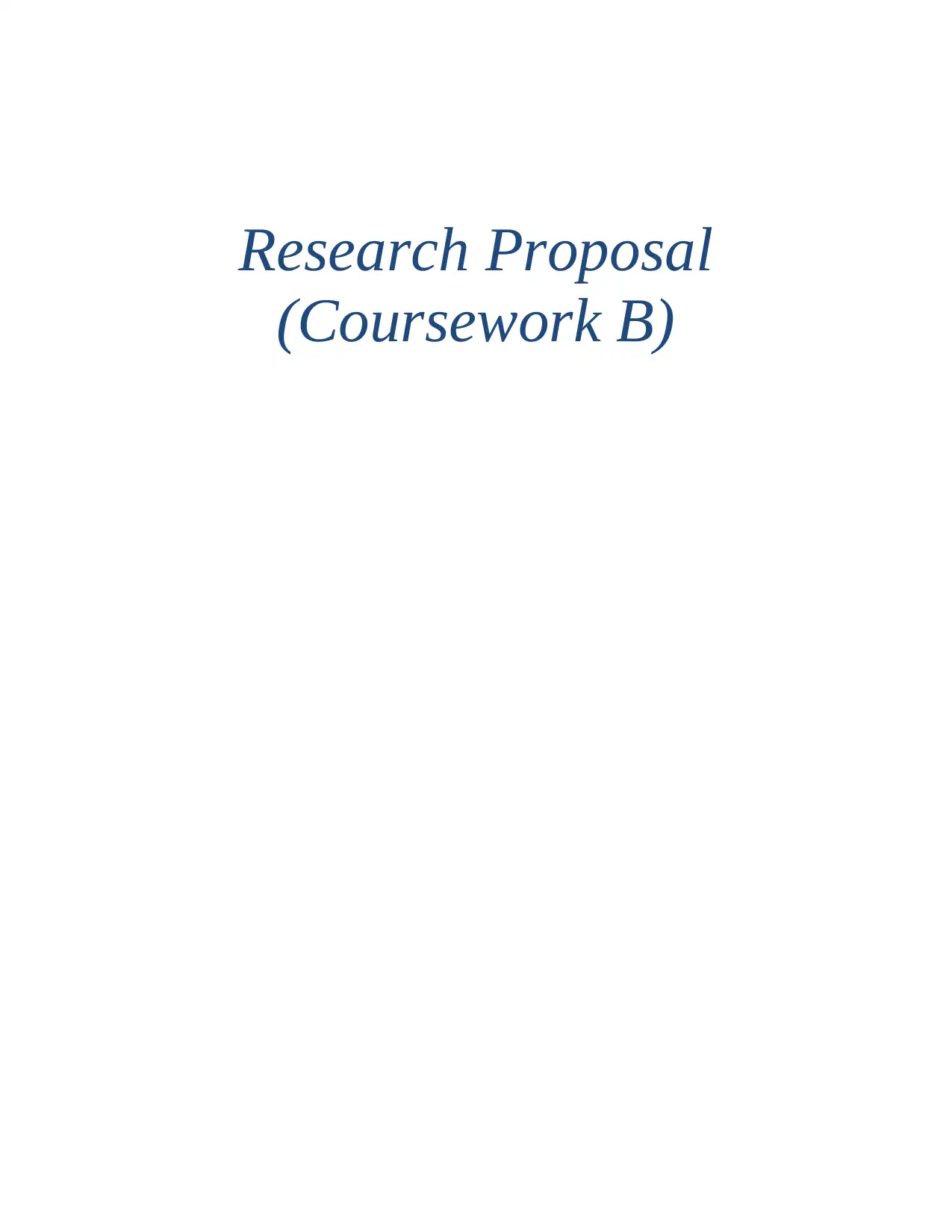
Research Proposal
(Coursework B)
(Coursework B)
Secure Best Marks with AI Grader
Need help grading? Try our AI Grader for instant feedback on your assignments.
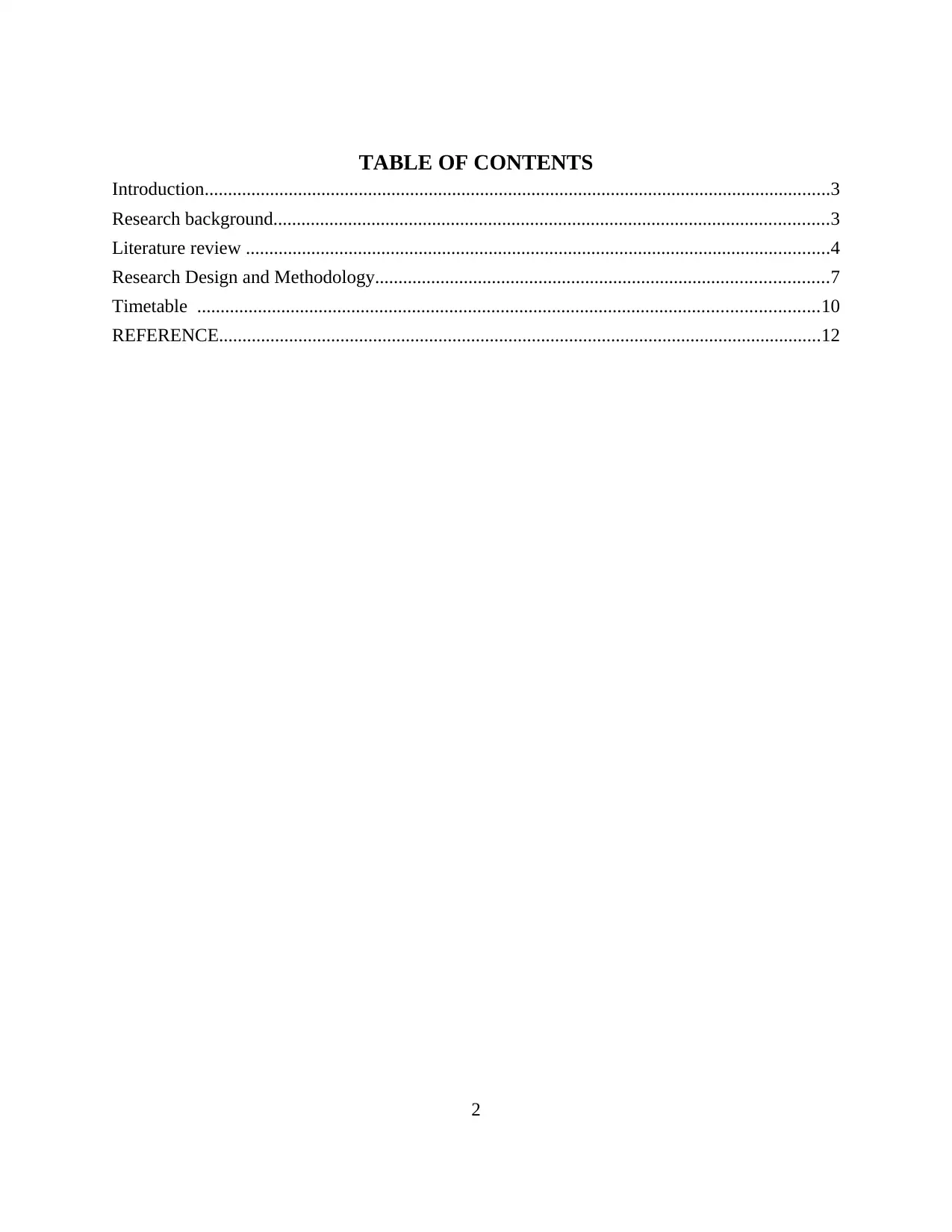
TABLE OF CONTENTS
Introduction......................................................................................................................................3
Research background.......................................................................................................................3
Literature review .............................................................................................................................4
Research Design and Methodology.................................................................................................7
Timetable .....................................................................................................................................10
REFERENCE.................................................................................................................................12
2
Introduction......................................................................................................................................3
Research background.......................................................................................................................3
Literature review .............................................................................................................................4
Research Design and Methodology.................................................................................................7
Timetable .....................................................................................................................................10
REFERENCE.................................................................................................................................12
2
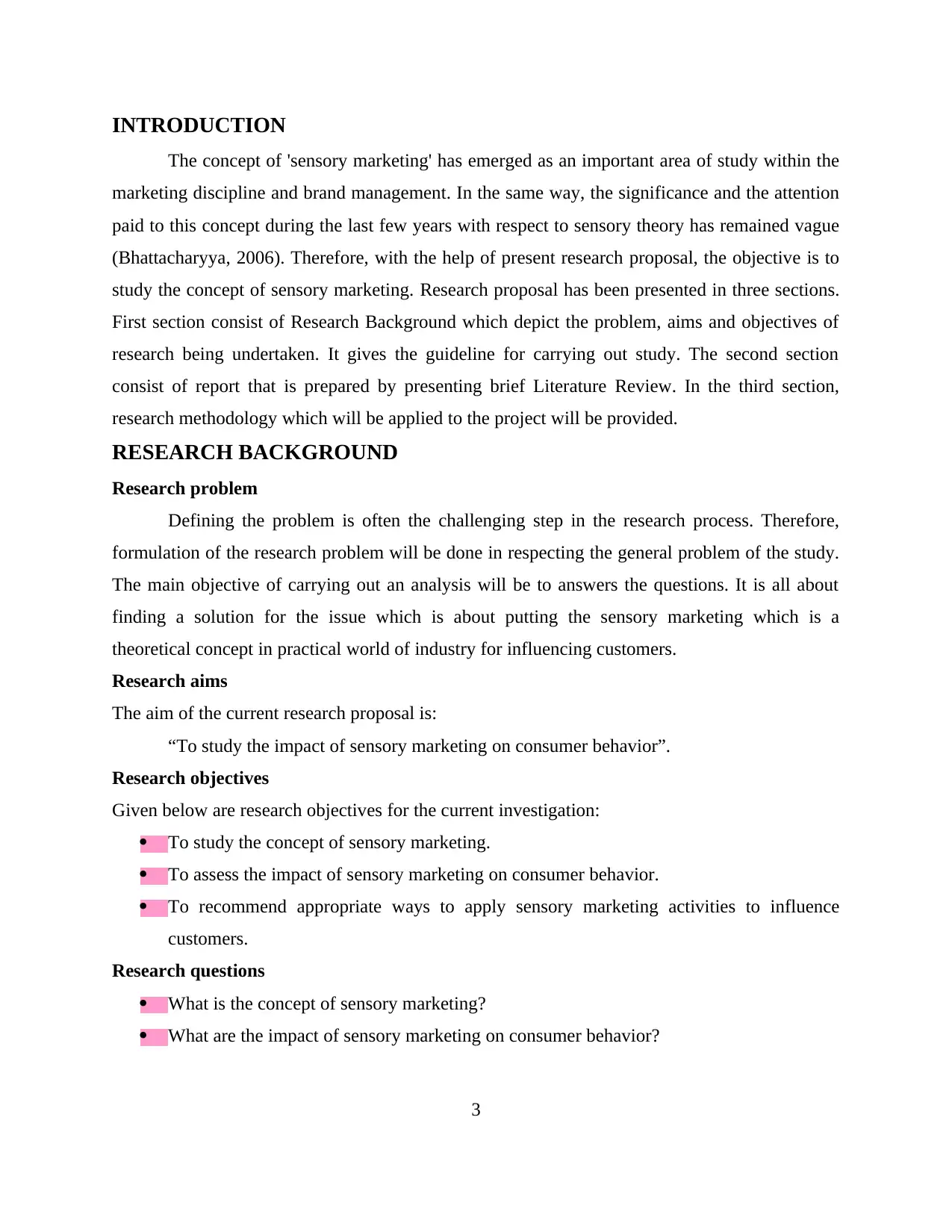
INTRODUCTION
The concept of 'sensory marketing' has emerged as an important area of study within the
marketing discipline and brand management. In the same way, the significance and the attention
paid to this concept during the last few years with respect to sensory theory has remained vague
(Bhattacharyya, 2006). Therefore, with the help of present research proposal, the objective is to
study the concept of sensory marketing. Research proposal has been presented in three sections.
First section consist of Research Background which depict the problem, aims and objectives of
research being undertaken. It gives the guideline for carrying out study. The second section
consist of report that is prepared by presenting brief Literature Review. In the third section,
research methodology which will be applied to the project will be provided.
RESEARCH BACKGROUND
Research problem
Defining the problem is often the challenging step in the research process. Therefore,
formulation of the research problem will be done in respecting the general problem of the study.
The main objective of carrying out an analysis will be to answers the questions. It is all about
finding a solution for the issue which is about putting the sensory marketing which is a
theoretical concept in practical world of industry for influencing customers.
Research aims
The aim of the current research proposal is:
“To study the impact of sensory marketing on consumer behavior”.
Research objectives
Given below are research objectives for the current investigation:
To study the concept of sensory marketing.
To assess the impact of sensory marketing on consumer behavior.
To recommend appropriate ways to apply sensory marketing activities to influence
customers.
Research questions
What is the concept of sensory marketing?
What are the impact of sensory marketing on consumer behavior?
3
The concept of 'sensory marketing' has emerged as an important area of study within the
marketing discipline and brand management. In the same way, the significance and the attention
paid to this concept during the last few years with respect to sensory theory has remained vague
(Bhattacharyya, 2006). Therefore, with the help of present research proposal, the objective is to
study the concept of sensory marketing. Research proposal has been presented in three sections.
First section consist of Research Background which depict the problem, aims and objectives of
research being undertaken. It gives the guideline for carrying out study. The second section
consist of report that is prepared by presenting brief Literature Review. In the third section,
research methodology which will be applied to the project will be provided.
RESEARCH BACKGROUND
Research problem
Defining the problem is often the challenging step in the research process. Therefore,
formulation of the research problem will be done in respecting the general problem of the study.
The main objective of carrying out an analysis will be to answers the questions. It is all about
finding a solution for the issue which is about putting the sensory marketing which is a
theoretical concept in practical world of industry for influencing customers.
Research aims
The aim of the current research proposal is:
“To study the impact of sensory marketing on consumer behavior”.
Research objectives
Given below are research objectives for the current investigation:
To study the concept of sensory marketing.
To assess the impact of sensory marketing on consumer behavior.
To recommend appropriate ways to apply sensory marketing activities to influence
customers.
Research questions
What is the concept of sensory marketing?
What are the impact of sensory marketing on consumer behavior?
3
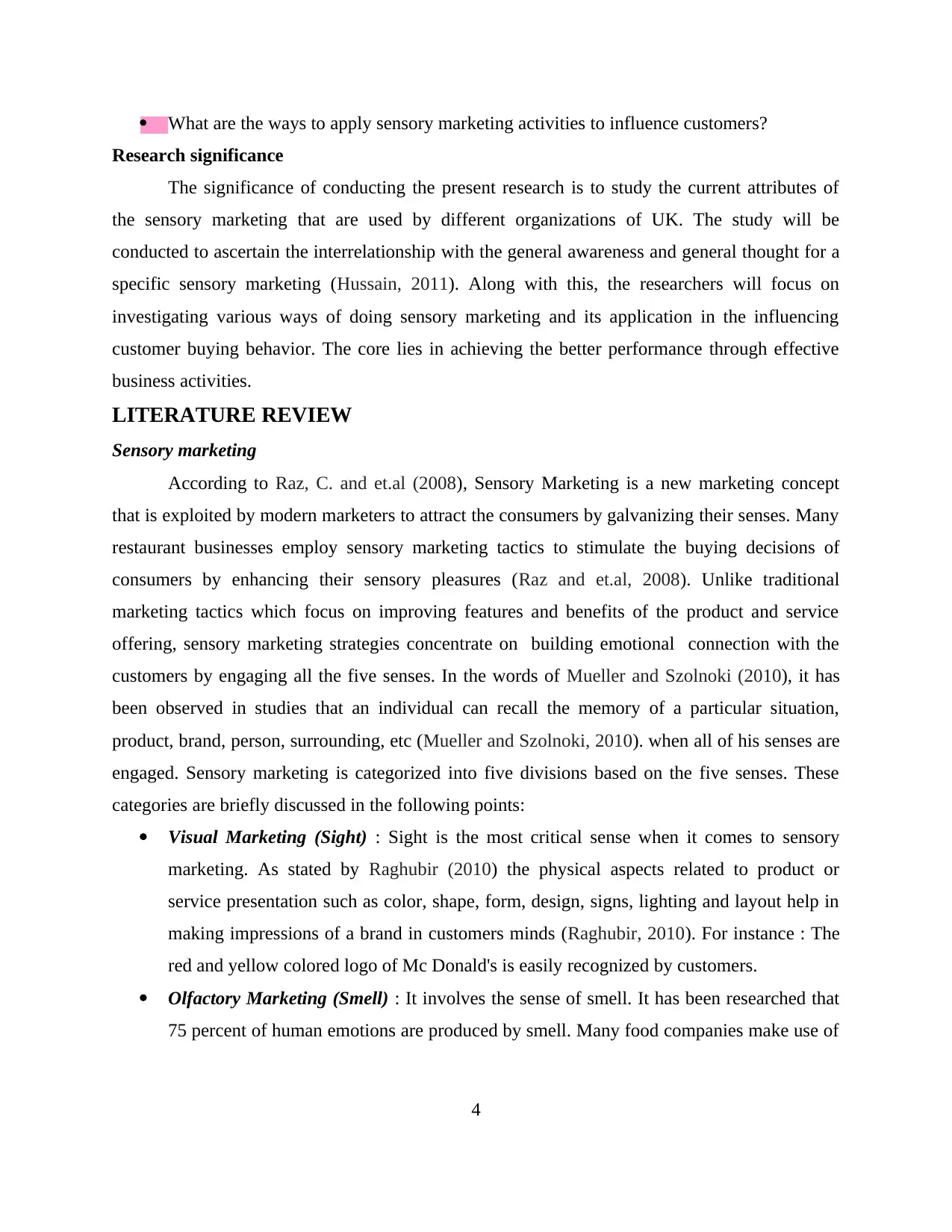
What are the ways to apply sensory marketing activities to influence customers?
Research significance
The significance of conducting the present research is to study the current attributes of
the sensory marketing that are used by different organizations of UK. The study will be
conducted to ascertain the interrelationship with the general awareness and general thought for a
specific sensory marketing (Hussain, 2011). Along with this, the researchers will focus on
investigating various ways of doing sensory marketing and its application in the influencing
customer buying behavior. The core lies in achieving the better performance through effective
business activities.
LITERATURE REVIEW
Sensory marketing
According to Raz, C. and et.al (2008), Sensory Marketing is a new marketing concept
that is exploited by modern marketers to attract the consumers by galvanizing their senses. Many
restaurant businesses employ sensory marketing tactics to stimulate the buying decisions of
consumers by enhancing their sensory pleasures (Raz and et.al, 2008). Unlike traditional
marketing tactics which focus on improving features and benefits of the product and service
offering, sensory marketing strategies concentrate on building emotional connection with the
customers by engaging all the five senses. In the words of Mueller and Szolnoki (2010), it has
been observed in studies that an individual can recall the memory of a particular situation,
product, brand, person, surrounding, etc (Mueller and Szolnoki, 2010). when all of his senses are
engaged. Sensory marketing is categorized into five divisions based on the five senses. These
categories are briefly discussed in the following points:
Visual Marketing (Sight) : Sight is the most critical sense when it comes to sensory
marketing. As stated by Raghubir (2010) the physical aspects related to product or
service presentation such as color, shape, form, design, signs, lighting and layout help in
making impressions of a brand in customers minds (Raghubir, 2010). For instance : The
red and yellow colored logo of Mc Donald's is easily recognized by customers.
Olfactory Marketing (Smell) : It involves the sense of smell. It has been researched that
75 percent of human emotions are produced by smell. Many food companies make use of
4
Research significance
The significance of conducting the present research is to study the current attributes of
the sensory marketing that are used by different organizations of UK. The study will be
conducted to ascertain the interrelationship with the general awareness and general thought for a
specific sensory marketing (Hussain, 2011). Along with this, the researchers will focus on
investigating various ways of doing sensory marketing and its application in the influencing
customer buying behavior. The core lies in achieving the better performance through effective
business activities.
LITERATURE REVIEW
Sensory marketing
According to Raz, C. and et.al (2008), Sensory Marketing is a new marketing concept
that is exploited by modern marketers to attract the consumers by galvanizing their senses. Many
restaurant businesses employ sensory marketing tactics to stimulate the buying decisions of
consumers by enhancing their sensory pleasures (Raz and et.al, 2008). Unlike traditional
marketing tactics which focus on improving features and benefits of the product and service
offering, sensory marketing strategies concentrate on building emotional connection with the
customers by engaging all the five senses. In the words of Mueller and Szolnoki (2010), it has
been observed in studies that an individual can recall the memory of a particular situation,
product, brand, person, surrounding, etc (Mueller and Szolnoki, 2010). when all of his senses are
engaged. Sensory marketing is categorized into five divisions based on the five senses. These
categories are briefly discussed in the following points:
Visual Marketing (Sight) : Sight is the most critical sense when it comes to sensory
marketing. As stated by Raghubir (2010) the physical aspects related to product or
service presentation such as color, shape, form, design, signs, lighting and layout help in
making impressions of a brand in customers minds (Raghubir, 2010). For instance : The
red and yellow colored logo of Mc Donald's is easily recognized by customers.
Olfactory Marketing (Smell) : It involves the sense of smell. It has been researched that
75 percent of human emotions are produced by smell. Many food companies make use of
4
Secure Best Marks with AI Grader
Need help grading? Try our AI Grader for instant feedback on your assignments.
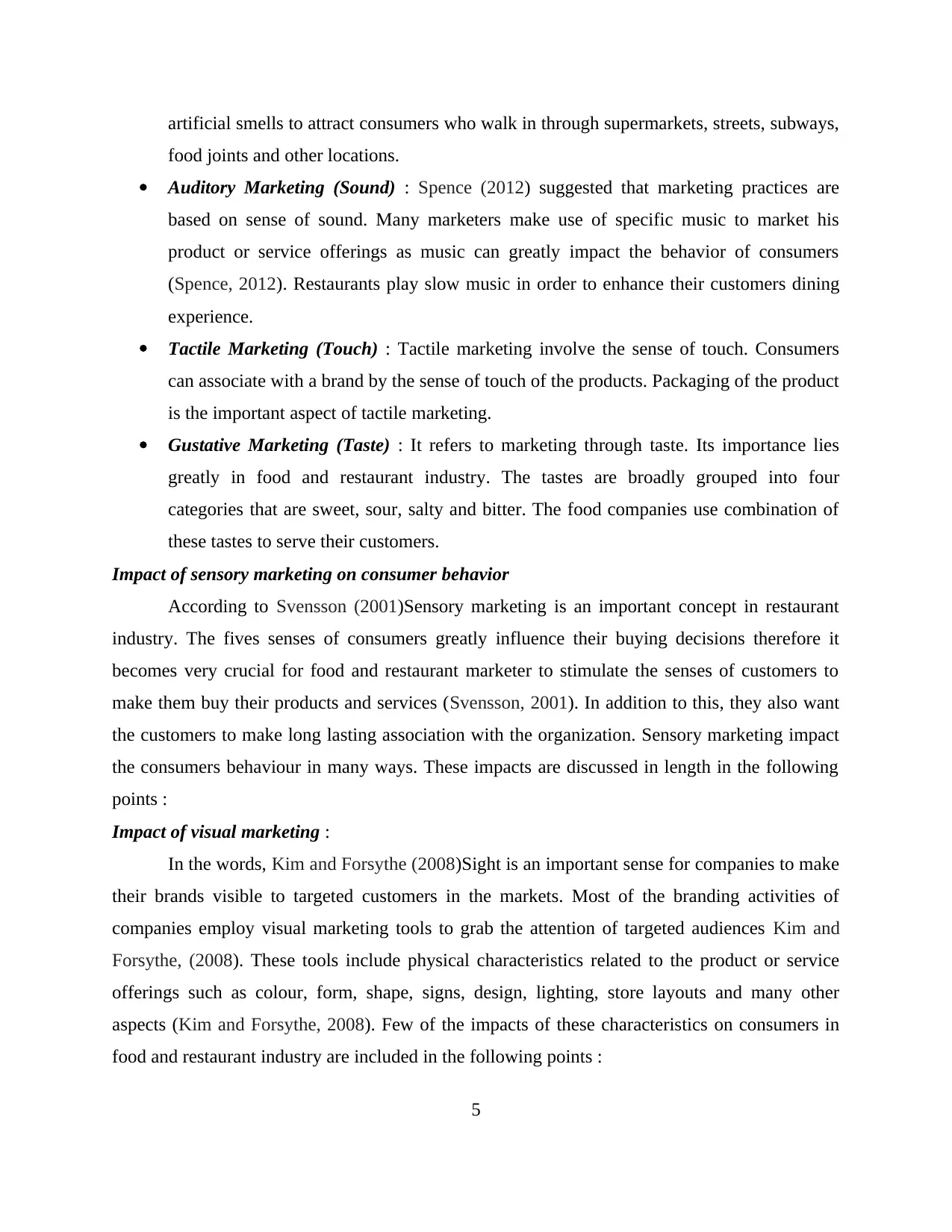
artificial smells to attract consumers who walk in through supermarkets, streets, subways,
food joints and other locations.
Auditory Marketing (Sound) : Spence (2012) suggested that marketing practices are
based on sense of sound. Many marketers make use of specific music to market his
product or service offerings as music can greatly impact the behavior of consumers
(Spence, 2012). Restaurants play slow music in order to enhance their customers dining
experience.
Tactile Marketing (Touch) : Tactile marketing involve the sense of touch. Consumers
can associate with a brand by the sense of touch of the products. Packaging of the product
is the important aspect of tactile marketing.
Gustative Marketing (Taste) : It refers to marketing through taste. Its importance lies
greatly in food and restaurant industry. The tastes are broadly grouped into four
categories that are sweet, sour, salty and bitter. The food companies use combination of
these tastes to serve their customers.
Impact of sensory marketing on consumer behavior
According to Svensson (2001)Sensory marketing is an important concept in restaurant
industry. The fives senses of consumers greatly influence their buying decisions therefore it
becomes very crucial for food and restaurant marketer to stimulate the senses of customers to
make them buy their products and services (Svensson, 2001). In addition to this, they also want
the customers to make long lasting association with the organization. Sensory marketing impact
the consumers behaviour in many ways. These impacts are discussed in length in the following
points :
Impact of visual marketing :
In the words, Kim and Forsythe (2008)Sight is an important sense for companies to make
their brands visible to targeted customers in the markets. Most of the branding activities of
companies employ visual marketing tools to grab the attention of targeted audiences Kim and
Forsythe, (2008). These tools include physical characteristics related to the product or service
offerings such as colour, form, shape, signs, design, lighting, store layouts and many other
aspects (Kim and Forsythe, 2008). Few of the impacts of these characteristics on consumers in
food and restaurant industry are included in the following points :
5
food joints and other locations.
Auditory Marketing (Sound) : Spence (2012) suggested that marketing practices are
based on sense of sound. Many marketers make use of specific music to market his
product or service offerings as music can greatly impact the behavior of consumers
(Spence, 2012). Restaurants play slow music in order to enhance their customers dining
experience.
Tactile Marketing (Touch) : Tactile marketing involve the sense of touch. Consumers
can associate with a brand by the sense of touch of the products. Packaging of the product
is the important aspect of tactile marketing.
Gustative Marketing (Taste) : It refers to marketing through taste. Its importance lies
greatly in food and restaurant industry. The tastes are broadly grouped into four
categories that are sweet, sour, salty and bitter. The food companies use combination of
these tastes to serve their customers.
Impact of sensory marketing on consumer behavior
According to Svensson (2001)Sensory marketing is an important concept in restaurant
industry. The fives senses of consumers greatly influence their buying decisions therefore it
becomes very crucial for food and restaurant marketer to stimulate the senses of customers to
make them buy their products and services (Svensson, 2001). In addition to this, they also want
the customers to make long lasting association with the organization. Sensory marketing impact
the consumers behaviour in many ways. These impacts are discussed in length in the following
points :
Impact of visual marketing :
In the words, Kim and Forsythe (2008)Sight is an important sense for companies to make
their brands visible to targeted customers in the markets. Most of the branding activities of
companies employ visual marketing tools to grab the attention of targeted audiences Kim and
Forsythe, (2008). These tools include physical characteristics related to the product or service
offerings such as colour, form, shape, signs, design, lighting, store layouts and many other
aspects (Kim and Forsythe, 2008). Few of the impacts of these characteristics on consumers in
food and restaurant industry are included in the following points :
5
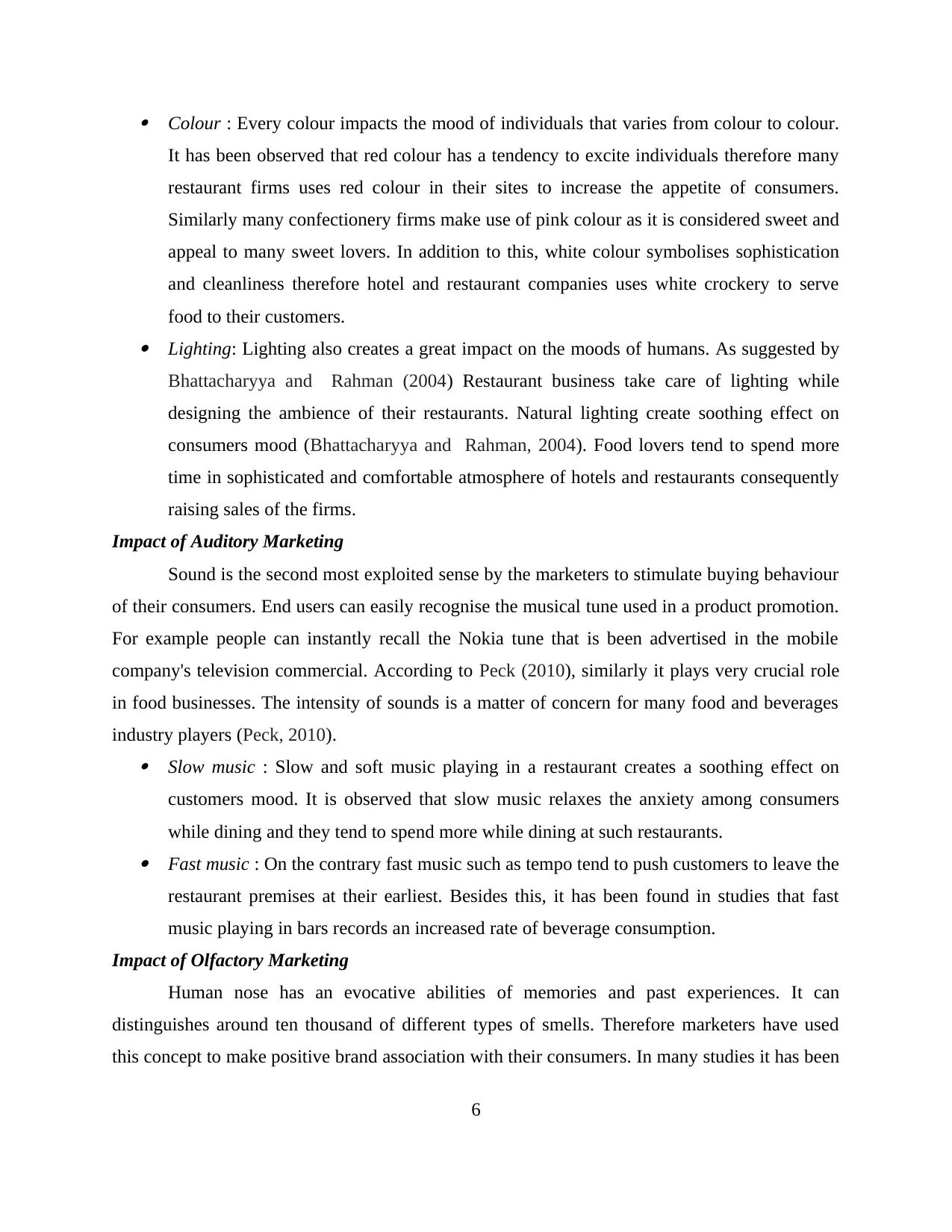
Colour : Every colour impacts the mood of individuals that varies from colour to colour.
It has been observed that red colour has a tendency to excite individuals therefore many
restaurant firms uses red colour in their sites to increase the appetite of consumers.
Similarly many confectionery firms make use of pink colour as it is considered sweet and
appeal to many sweet lovers. In addition to this, white colour symbolises sophistication
and cleanliness therefore hotel and restaurant companies uses white crockery to serve
food to their customers. Lighting: Lighting also creates a great impact on the moods of humans. As suggested by
Bhattacharyya and Rahman (2004) Restaurant business take care of lighting while
designing the ambience of their restaurants. Natural lighting create soothing effect on
consumers mood (Bhattacharyya and Rahman, 2004). Food lovers tend to spend more
time in sophisticated and comfortable atmosphere of hotels and restaurants consequently
raising sales of the firms.
Impact of Auditory Marketing
Sound is the second most exploited sense by the marketers to stimulate buying behaviour
of their consumers. End users can easily recognise the musical tune used in a product promotion.
For example people can instantly recall the Nokia tune that is been advertised in the mobile
company's television commercial. According to Peck (2010), similarly it plays very crucial role
in food businesses. The intensity of sounds is a matter of concern for many food and beverages
industry players (Peck, 2010). Slow music : Slow and soft music playing in a restaurant creates a soothing effect on
customers mood. It is observed that slow music relaxes the anxiety among consumers
while dining and they tend to spend more while dining at such restaurants. Fast music : On the contrary fast music such as tempo tend to push customers to leave the
restaurant premises at their earliest. Besides this, it has been found in studies that fast
music playing in bars records an increased rate of beverage consumption.
Impact of Olfactory Marketing
Human nose has an evocative abilities of memories and past experiences. It can
distinguishes around ten thousand of different types of smells. Therefore marketers have used
this concept to make positive brand association with their consumers. In many studies it has been
6
It has been observed that red colour has a tendency to excite individuals therefore many
restaurant firms uses red colour in their sites to increase the appetite of consumers.
Similarly many confectionery firms make use of pink colour as it is considered sweet and
appeal to many sweet lovers. In addition to this, white colour symbolises sophistication
and cleanliness therefore hotel and restaurant companies uses white crockery to serve
food to their customers. Lighting: Lighting also creates a great impact on the moods of humans. As suggested by
Bhattacharyya and Rahman (2004) Restaurant business take care of lighting while
designing the ambience of their restaurants. Natural lighting create soothing effect on
consumers mood (Bhattacharyya and Rahman, 2004). Food lovers tend to spend more
time in sophisticated and comfortable atmosphere of hotels and restaurants consequently
raising sales of the firms.
Impact of Auditory Marketing
Sound is the second most exploited sense by the marketers to stimulate buying behaviour
of their consumers. End users can easily recognise the musical tune used in a product promotion.
For example people can instantly recall the Nokia tune that is been advertised in the mobile
company's television commercial. According to Peck (2010), similarly it plays very crucial role
in food businesses. The intensity of sounds is a matter of concern for many food and beverages
industry players (Peck, 2010). Slow music : Slow and soft music playing in a restaurant creates a soothing effect on
customers mood. It is observed that slow music relaxes the anxiety among consumers
while dining and they tend to spend more while dining at such restaurants. Fast music : On the contrary fast music such as tempo tend to push customers to leave the
restaurant premises at their earliest. Besides this, it has been found in studies that fast
music playing in bars records an increased rate of beverage consumption.
Impact of Olfactory Marketing
Human nose has an evocative abilities of memories and past experiences. It can
distinguishes around ten thousand of different types of smells. Therefore marketers have used
this concept to make positive brand association with their consumers. In many studies it has been
6
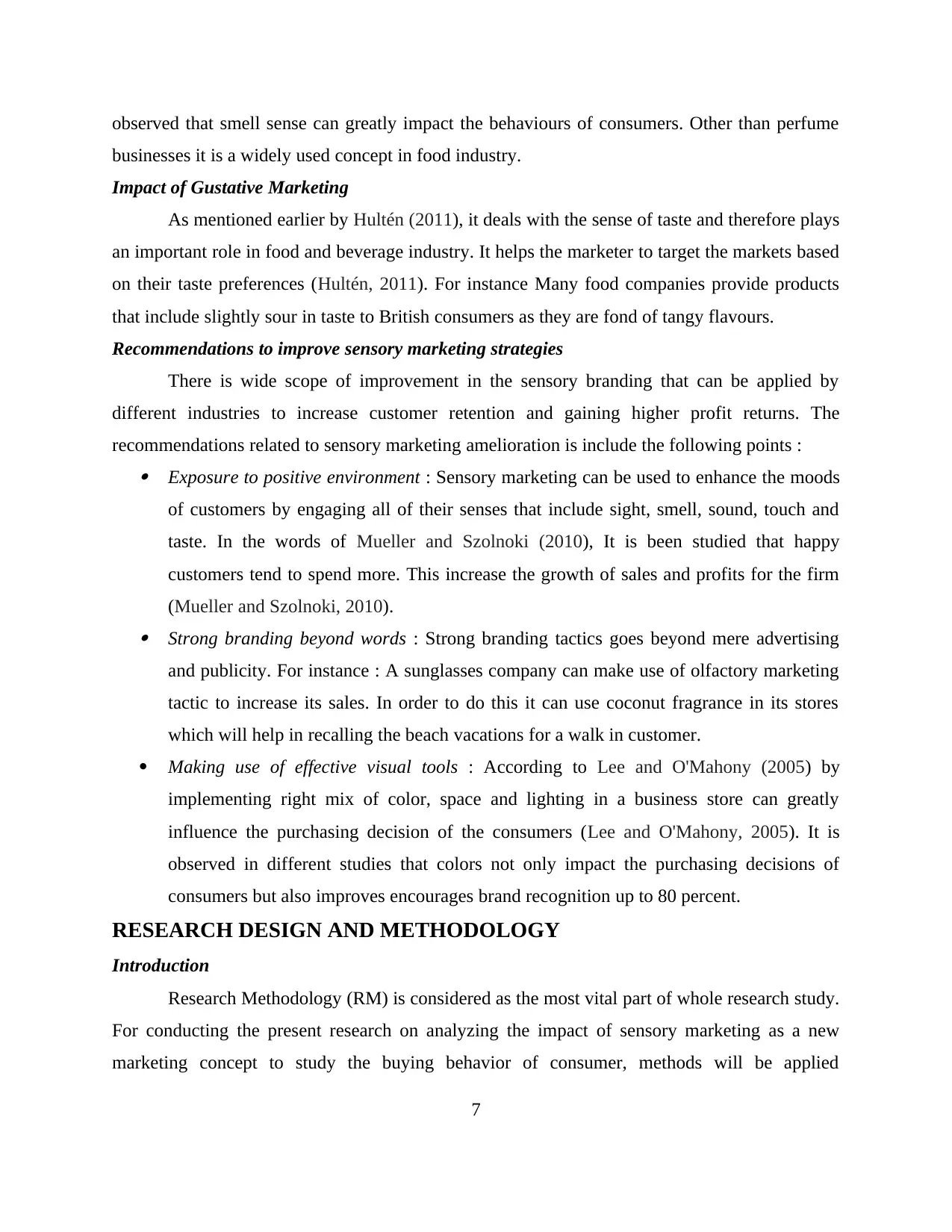
observed that smell sense can greatly impact the behaviours of consumers. Other than perfume
businesses it is a widely used concept in food industry.
Impact of Gustative Marketing
As mentioned earlier by Hultén (2011), it deals with the sense of taste and therefore plays
an important role in food and beverage industry. It helps the marketer to target the markets based
on their taste preferences (Hultén, 2011). For instance Many food companies provide products
that include slightly sour in taste to British consumers as they are fond of tangy flavours.
Recommendations to improve sensory marketing strategies
There is wide scope of improvement in the sensory branding that can be applied by
different industries to increase customer retention and gaining higher profit returns. The
recommendations related to sensory marketing amelioration is include the following points : Exposure to positive environment : Sensory marketing can be used to enhance the moods
of customers by engaging all of their senses that include sight, smell, sound, touch and
taste. In the words of Mueller and Szolnoki (2010), It is been studied that happy
customers tend to spend more. This increase the growth of sales and profits for the firm
(Mueller and Szolnoki, 2010). Strong branding beyond words : Strong branding tactics goes beyond mere advertising
and publicity. For instance : A sunglasses company can make use of olfactory marketing
tactic to increase its sales. In order to do this it can use coconut fragrance in its stores
which will help in recalling the beach vacations for a walk in customer.
Making use of effective visual tools : According to Lee and O'Mahony (2005) by
implementing right mix of color, space and lighting in a business store can greatly
influence the purchasing decision of the consumers (Lee and O'Mahony, 2005). It is
observed in different studies that colors not only impact the purchasing decisions of
consumers but also improves encourages brand recognition up to 80 percent.
RESEARCH DESIGN AND METHODOLOGY
Introduction
Research Methodology (RM) is considered as the most vital part of whole research study.
For conducting the present research on analyzing the impact of sensory marketing as a new
marketing concept to study the buying behavior of consumer, methods will be applied
7
businesses it is a widely used concept in food industry.
Impact of Gustative Marketing
As mentioned earlier by Hultén (2011), it deals with the sense of taste and therefore plays
an important role in food and beverage industry. It helps the marketer to target the markets based
on their taste preferences (Hultén, 2011). For instance Many food companies provide products
that include slightly sour in taste to British consumers as they are fond of tangy flavours.
Recommendations to improve sensory marketing strategies
There is wide scope of improvement in the sensory branding that can be applied by
different industries to increase customer retention and gaining higher profit returns. The
recommendations related to sensory marketing amelioration is include the following points : Exposure to positive environment : Sensory marketing can be used to enhance the moods
of customers by engaging all of their senses that include sight, smell, sound, touch and
taste. In the words of Mueller and Szolnoki (2010), It is been studied that happy
customers tend to spend more. This increase the growth of sales and profits for the firm
(Mueller and Szolnoki, 2010). Strong branding beyond words : Strong branding tactics goes beyond mere advertising
and publicity. For instance : A sunglasses company can make use of olfactory marketing
tactic to increase its sales. In order to do this it can use coconut fragrance in its stores
which will help in recalling the beach vacations for a walk in customer.
Making use of effective visual tools : According to Lee and O'Mahony (2005) by
implementing right mix of color, space and lighting in a business store can greatly
influence the purchasing decision of the consumers (Lee and O'Mahony, 2005). It is
observed in different studies that colors not only impact the purchasing decisions of
consumers but also improves encourages brand recognition up to 80 percent.
RESEARCH DESIGN AND METHODOLOGY
Introduction
Research Methodology (RM) is considered as the most vital part of whole research study.
For conducting the present research on analyzing the impact of sensory marketing as a new
marketing concept to study the buying behavior of consumer, methods will be applied
7
Paraphrase This Document
Need a fresh take? Get an instant paraphrase of this document with our AI Paraphraser
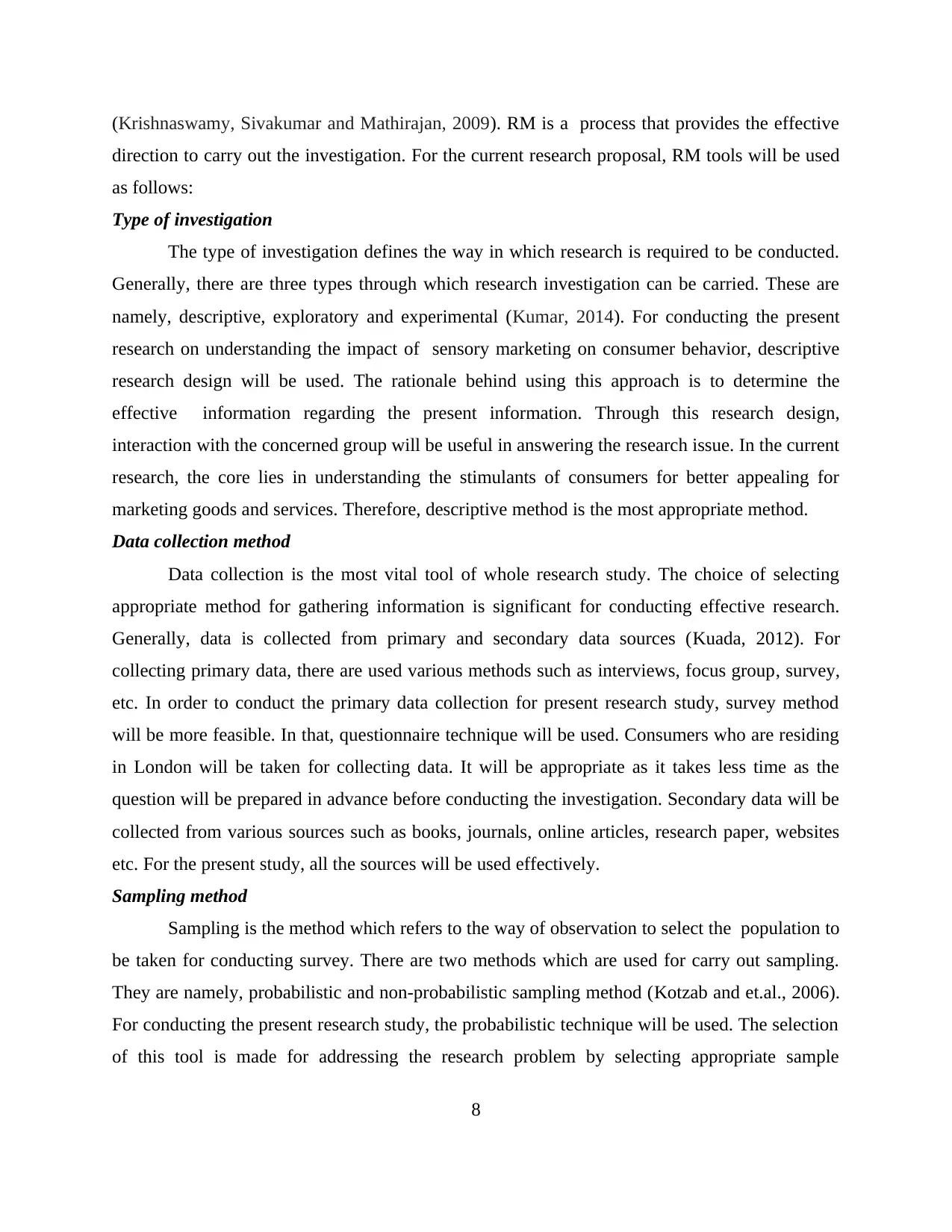
(Krishnaswamy, Sivakumar and Mathirajan, 2009). RM is a process that provides the effective
direction to carry out the investigation. For the current research proposal, RM tools will be used
as follows:
Type of investigation
The type of investigation defines the way in which research is required to be conducted.
Generally, there are three types through which research investigation can be carried. These are
namely, descriptive, exploratory and experimental (Kumar, 2014). For conducting the present
research on understanding the impact of sensory marketing on consumer behavior, descriptive
research design will be used. The rationale behind using this approach is to determine the
effective information regarding the present information. Through this research design,
interaction with the concerned group will be useful in answering the research issue. In the current
research, the core lies in understanding the stimulants of consumers for better appealing for
marketing goods and services. Therefore, descriptive method is the most appropriate method.
Data collection method
Data collection is the most vital tool of whole research study. The choice of selecting
appropriate method for gathering information is significant for conducting effective research.
Generally, data is collected from primary and secondary data sources (Kuada, 2012). For
collecting primary data, there are used various methods such as interviews, focus group, survey,
etc. In order to conduct the primary data collection for present research study, survey method
will be more feasible. In that, questionnaire technique will be used. Consumers who are residing
in London will be taken for collecting data. It will be appropriate as it takes less time as the
question will be prepared in advance before conducting the investigation. Secondary data will be
collected from various sources such as books, journals, online articles, research paper, websites
etc. For the present study, all the sources will be used effectively.
Sampling method
Sampling is the method which refers to the way of observation to select the population to
be taken for conducting survey. There are two methods which are used for carry out sampling.
They are namely, probabilistic and non-probabilistic sampling method (Kotzab and et.al., 2006).
For conducting the present research study, the probabilistic technique will be used. The selection
of this tool is made for addressing the research problem by selecting appropriate sample
8
direction to carry out the investigation. For the current research proposal, RM tools will be used
as follows:
Type of investigation
The type of investigation defines the way in which research is required to be conducted.
Generally, there are three types through which research investigation can be carried. These are
namely, descriptive, exploratory and experimental (Kumar, 2014). For conducting the present
research on understanding the impact of sensory marketing on consumer behavior, descriptive
research design will be used. The rationale behind using this approach is to determine the
effective information regarding the present information. Through this research design,
interaction with the concerned group will be useful in answering the research issue. In the current
research, the core lies in understanding the stimulants of consumers for better appealing for
marketing goods and services. Therefore, descriptive method is the most appropriate method.
Data collection method
Data collection is the most vital tool of whole research study. The choice of selecting
appropriate method for gathering information is significant for conducting effective research.
Generally, data is collected from primary and secondary data sources (Kuada, 2012). For
collecting primary data, there are used various methods such as interviews, focus group, survey,
etc. In order to conduct the primary data collection for present research study, survey method
will be more feasible. In that, questionnaire technique will be used. Consumers who are residing
in London will be taken for collecting data. It will be appropriate as it takes less time as the
question will be prepared in advance before conducting the investigation. Secondary data will be
collected from various sources such as books, journals, online articles, research paper, websites
etc. For the present study, all the sources will be used effectively.
Sampling method
Sampling is the method which refers to the way of observation to select the population to
be taken for conducting survey. There are two methods which are used for carry out sampling.
They are namely, probabilistic and non-probabilistic sampling method (Kotzab and et.al., 2006).
For conducting the present research study, the probabilistic technique will be used. The selection
of this tool is made for addressing the research problem by selecting appropriate sample
8
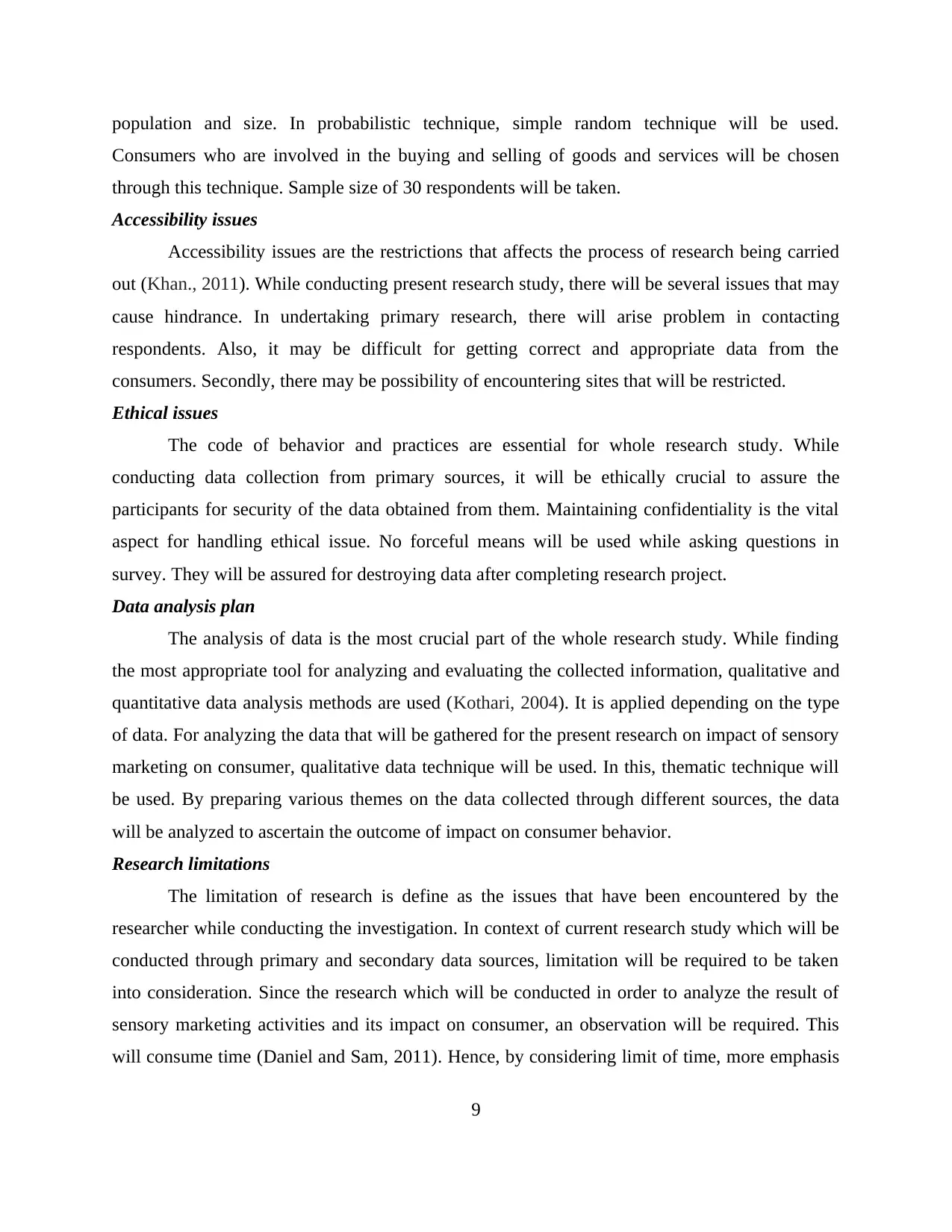
population and size. In probabilistic technique, simple random technique will be used.
Consumers who are involved in the buying and selling of goods and services will be chosen
through this technique. Sample size of 30 respondents will be taken.
Accessibility issues
Accessibility issues are the restrictions that affects the process of research being carried
out (Khan., 2011). While conducting present research study, there will be several issues that may
cause hindrance. In undertaking primary research, there will arise problem in contacting
respondents. Also, it may be difficult for getting correct and appropriate data from the
consumers. Secondly, there may be possibility of encountering sites that will be restricted.
Ethical issues
The code of behavior and practices are essential for whole research study. While
conducting data collection from primary sources, it will be ethically crucial to assure the
participants for security of the data obtained from them. Maintaining confidentiality is the vital
aspect for handling ethical issue. No forceful means will be used while asking questions in
survey. They will be assured for destroying data after completing research project.
Data analysis plan
The analysis of data is the most crucial part of the whole research study. While finding
the most appropriate tool for analyzing and evaluating the collected information, qualitative and
quantitative data analysis methods are used (Kothari, 2004). It is applied depending on the type
of data. For analyzing the data that will be gathered for the present research on impact of sensory
marketing on consumer, qualitative data technique will be used. In this, thematic technique will
be used. By preparing various themes on the data collected through different sources, the data
will be analyzed to ascertain the outcome of impact on consumer behavior.
Research limitations
The limitation of research is define as the issues that have been encountered by the
researcher while conducting the investigation. In context of current research study which will be
conducted through primary and secondary data sources, limitation will be required to be taken
into consideration. Since the research which will be conducted in order to analyze the result of
sensory marketing activities and its impact on consumer, an observation will be required. This
will consume time (Daniel and Sam, 2011). Hence, by considering limit of time, more emphasis
9
Consumers who are involved in the buying and selling of goods and services will be chosen
through this technique. Sample size of 30 respondents will be taken.
Accessibility issues
Accessibility issues are the restrictions that affects the process of research being carried
out (Khan., 2011). While conducting present research study, there will be several issues that may
cause hindrance. In undertaking primary research, there will arise problem in contacting
respondents. Also, it may be difficult for getting correct and appropriate data from the
consumers. Secondly, there may be possibility of encountering sites that will be restricted.
Ethical issues
The code of behavior and practices are essential for whole research study. While
conducting data collection from primary sources, it will be ethically crucial to assure the
participants for security of the data obtained from them. Maintaining confidentiality is the vital
aspect for handling ethical issue. No forceful means will be used while asking questions in
survey. They will be assured for destroying data after completing research project.
Data analysis plan
The analysis of data is the most crucial part of the whole research study. While finding
the most appropriate tool for analyzing and evaluating the collected information, qualitative and
quantitative data analysis methods are used (Kothari, 2004). It is applied depending on the type
of data. For analyzing the data that will be gathered for the present research on impact of sensory
marketing on consumer, qualitative data technique will be used. In this, thematic technique will
be used. By preparing various themes on the data collected through different sources, the data
will be analyzed to ascertain the outcome of impact on consumer behavior.
Research limitations
The limitation of research is define as the issues that have been encountered by the
researcher while conducting the investigation. In context of current research study which will be
conducted through primary and secondary data sources, limitation will be required to be taken
into consideration. Since the research which will be conducted in order to analyze the result of
sensory marketing activities and its impact on consumer, an observation will be required. This
will consume time (Daniel and Sam, 2011). Hence, by considering limit of time, more emphasis
9
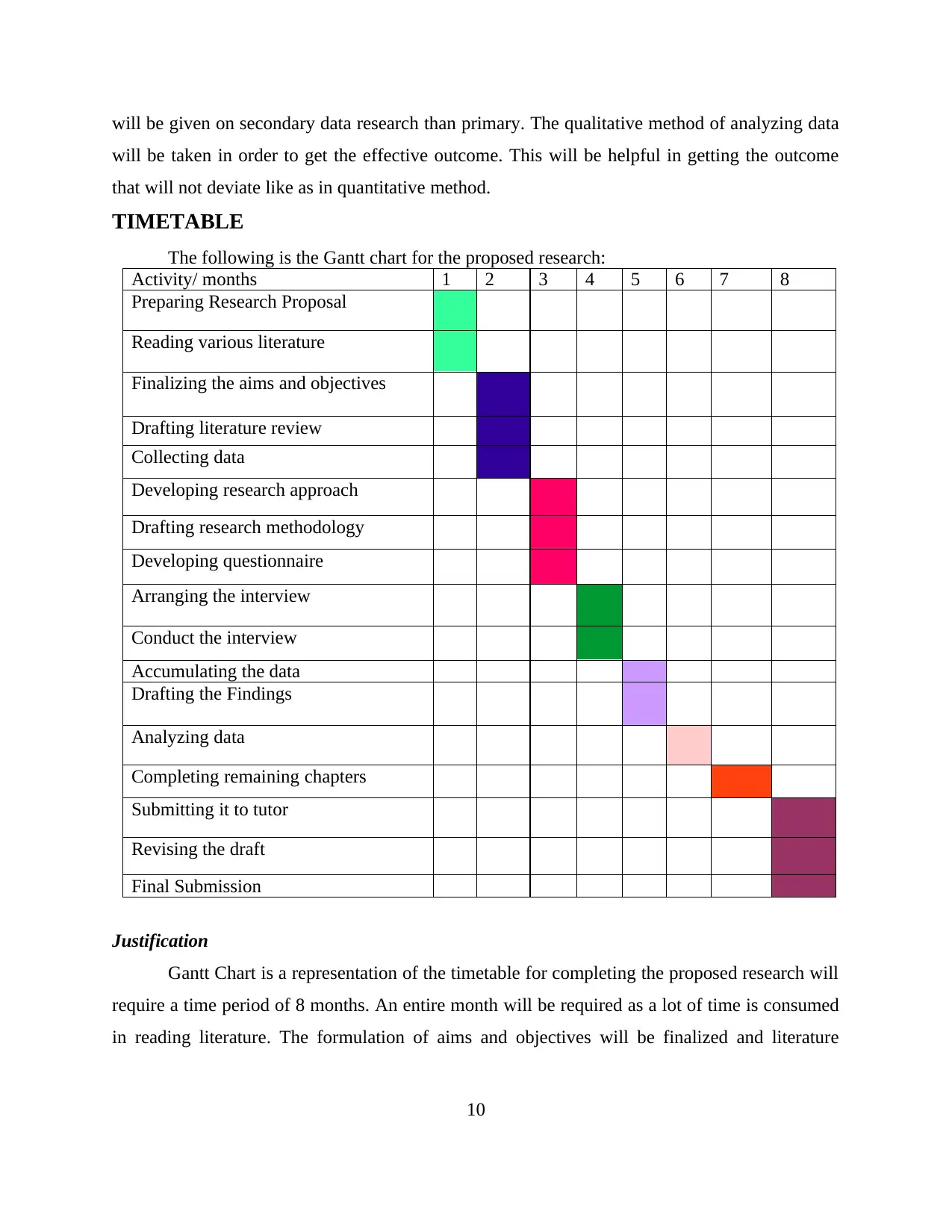
will be given on secondary data research than primary. The qualitative method of analyzing data
will be taken in order to get the effective outcome. This will be helpful in getting the outcome
that will not deviate like as in quantitative method.
TIMETABLE
The following is the Gantt chart for the proposed research:
Activity/ months 1 2 3 4 5 6 7 8
Preparing Research Proposal
Reading various literature
Finalizing the aims and objectives
Drafting literature review
Collecting data
Developing research approach
Drafting research methodology
Developing questionnaire
Arranging the interview
Conduct the interview
Accumulating the data
Drafting the Findings
Analyzing data
Completing remaining chapters
Submitting it to tutor
Revising the draft
Final Submission
Justification
Gantt Chart is a representation of the timetable for completing the proposed research will
require a time period of 8 months. An entire month will be required as a lot of time is consumed
in reading literature. The formulation of aims and objectives will be finalized and literature
10
will be taken in order to get the effective outcome. This will be helpful in getting the outcome
that will not deviate like as in quantitative method.
TIMETABLE
The following is the Gantt chart for the proposed research:
Activity/ months 1 2 3 4 5 6 7 8
Preparing Research Proposal
Reading various literature
Finalizing the aims and objectives
Drafting literature review
Collecting data
Developing research approach
Drafting research methodology
Developing questionnaire
Arranging the interview
Conduct the interview
Accumulating the data
Drafting the Findings
Analyzing data
Completing remaining chapters
Submitting it to tutor
Revising the draft
Final Submission
Justification
Gantt Chart is a representation of the timetable for completing the proposed research will
require a time period of 8 months. An entire month will be required as a lot of time is consumed
in reading literature. The formulation of aims and objectives will be finalized and literature
10
Secure Best Marks with AI Grader
Need help grading? Try our AI Grader for instant feedback on your assignments.
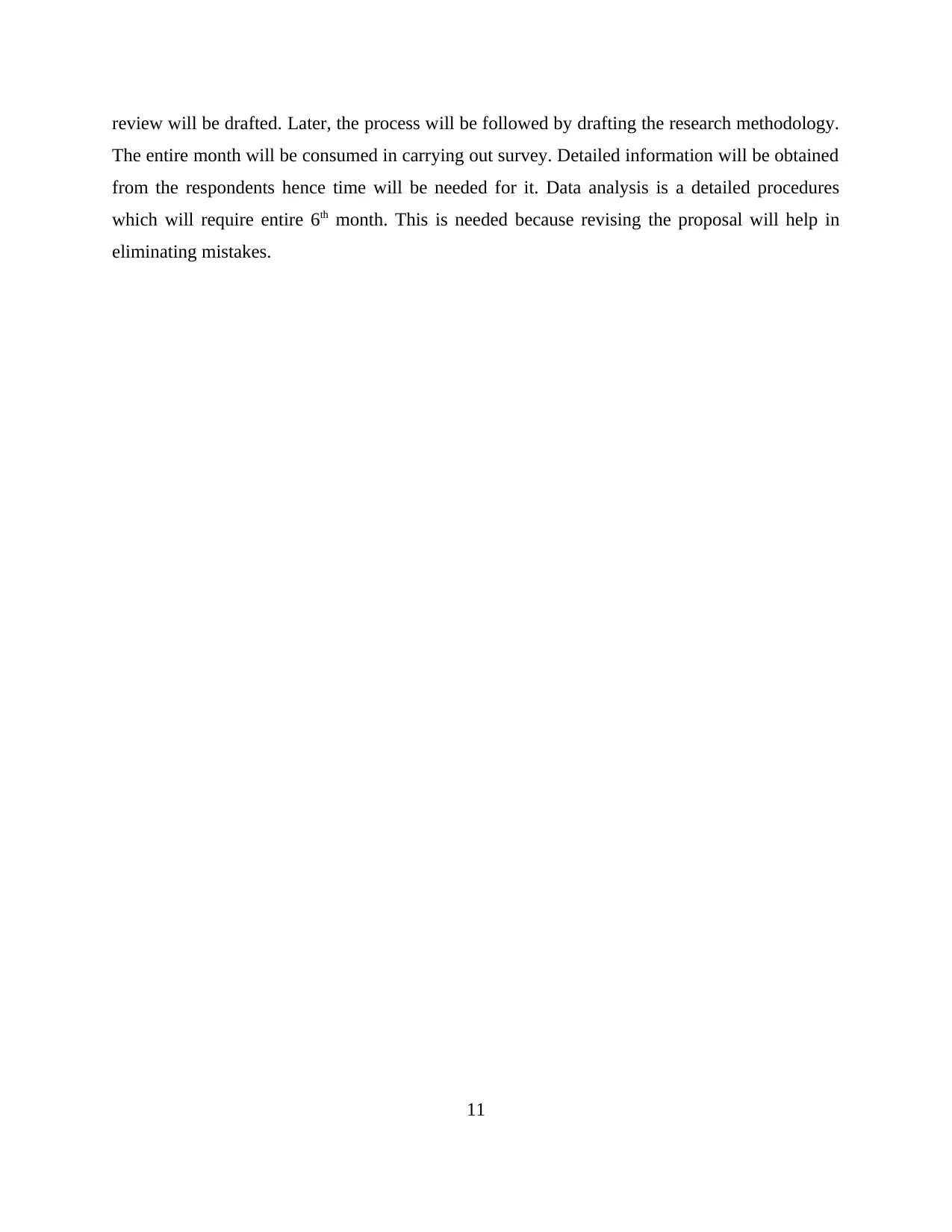
review will be drafted. Later, the process will be followed by drafting the research methodology.
The entire month will be consumed in carrying out survey. Detailed information will be obtained
from the respondents hence time will be needed for it. Data analysis is a detailed procedures
which will require entire 6th month. This is needed because revising the proposal will help in
eliminating mistakes.
11
The entire month will be consumed in carrying out survey. Detailed information will be obtained
from the respondents hence time will be needed for it. Data analysis is a detailed procedures
which will require entire 6th month. This is needed because revising the proposal will help in
eliminating mistakes.
11
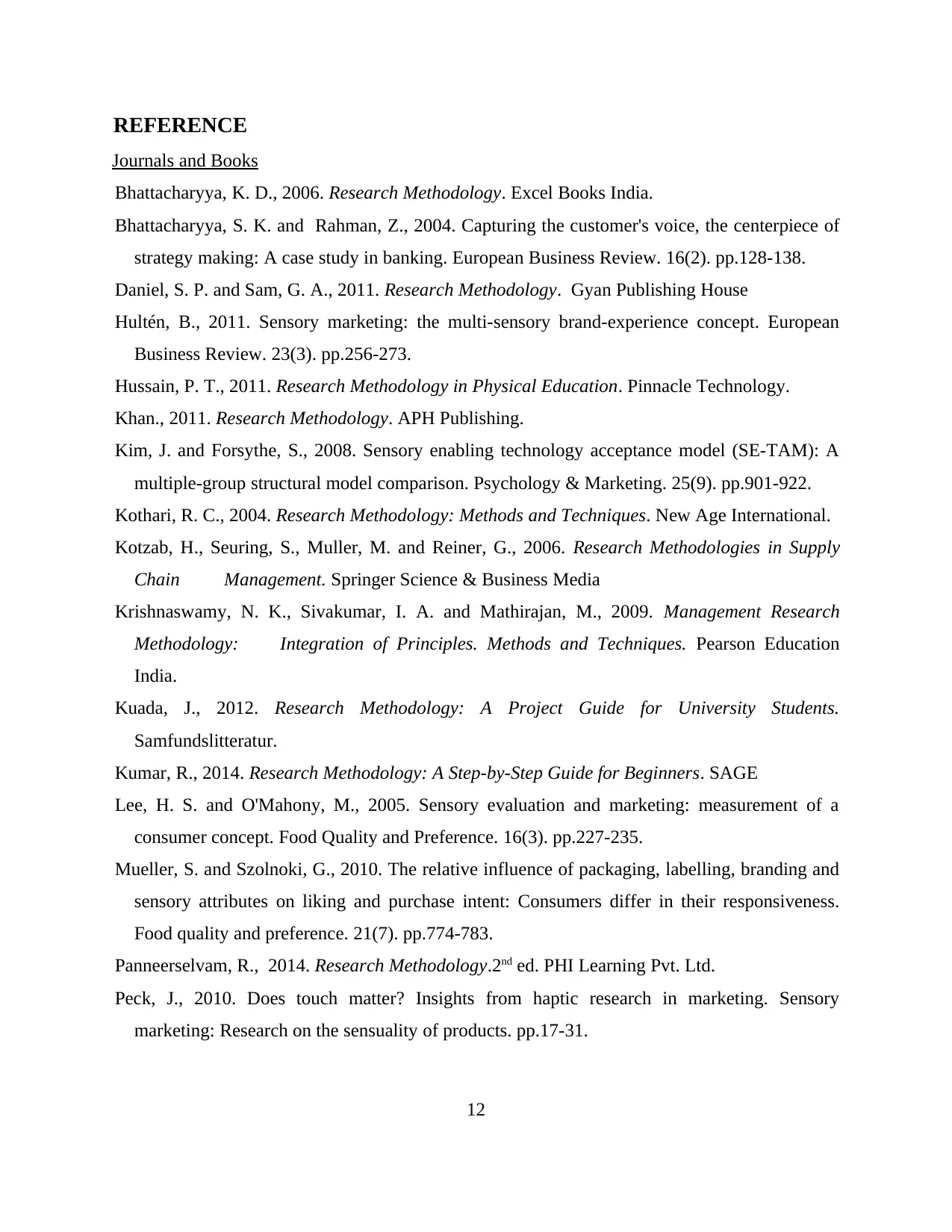
REFERENCE
Journals and Books
Bhattacharyya, K. D., 2006. Research Methodology. Excel Books India.
Bhattacharyya, S. K. and Rahman, Z., 2004. Capturing the customer's voice, the centerpiece of
strategy making: A case study in banking. European Business Review. 16(2). pp.128-138.
Daniel, S. P. and Sam, G. A., 2011. Research Methodology. Gyan Publishing House
Hultén, B., 2011. Sensory marketing: the multi-sensory brand-experience concept. European
Business Review. 23(3). pp.256-273.
Hussain, P. T., 2011. Research Methodology in Physical Education. Pinnacle Technology.
Khan., 2011. Research Methodology. APH Publishing.
Kim, J. and Forsythe, S., 2008. Sensory enabling technology acceptance model (SE‐TAM): A
multiple‐group structural model comparison. Psychology & Marketing. 25(9). pp.901-922.
Kothari, R. C., 2004. Research Methodology: Methods and Techniques. New Age International.
Kotzab, H., Seuring, S., Muller, M. and Reiner, G., 2006. Research Methodologies in Supply
Chain Management. Springer Science & Business Media
Krishnaswamy, N. K., Sivakumar, I. A. and Mathirajan, M., 2009. Management Research
Methodology: Integration of Principles. Methods and Techniques. Pearson Education
India.
Kuada, J., 2012. Research Methodology: A Project Guide for University Students.
Samfundslitteratur.
Kumar, R., 2014. Research Methodology: A Step-by-Step Guide for Beginners. SAGE
Lee, H. S. and O'Mahony, M., 2005. Sensory evaluation and marketing: measurement of a
consumer concept. Food Quality and Preference. 16(3). pp.227-235.
Mueller, S. and Szolnoki, G., 2010. The relative influence of packaging, labelling, branding and
sensory attributes on liking and purchase intent: Consumers differ in their responsiveness.
Food quality and preference. 21(7). pp.774-783.
Panneerselvam, R., 2014. Research Methodology.2nd ed. PHI Learning Pvt. Ltd.
Peck, J., 2010. Does touch matter? Insights from haptic research in marketing. Sensory
marketing: Research on the sensuality of products. pp.17-31.
12
Journals and Books
Bhattacharyya, K. D., 2006. Research Methodology. Excel Books India.
Bhattacharyya, S. K. and Rahman, Z., 2004. Capturing the customer's voice, the centerpiece of
strategy making: A case study in banking. European Business Review. 16(2). pp.128-138.
Daniel, S. P. and Sam, G. A., 2011. Research Methodology. Gyan Publishing House
Hultén, B., 2011. Sensory marketing: the multi-sensory brand-experience concept. European
Business Review. 23(3). pp.256-273.
Hussain, P. T., 2011. Research Methodology in Physical Education. Pinnacle Technology.
Khan., 2011. Research Methodology. APH Publishing.
Kim, J. and Forsythe, S., 2008. Sensory enabling technology acceptance model (SE‐TAM): A
multiple‐group structural model comparison. Psychology & Marketing. 25(9). pp.901-922.
Kothari, R. C., 2004. Research Methodology: Methods and Techniques. New Age International.
Kotzab, H., Seuring, S., Muller, M. and Reiner, G., 2006. Research Methodologies in Supply
Chain Management. Springer Science & Business Media
Krishnaswamy, N. K., Sivakumar, I. A. and Mathirajan, M., 2009. Management Research
Methodology: Integration of Principles. Methods and Techniques. Pearson Education
India.
Kuada, J., 2012. Research Methodology: A Project Guide for University Students.
Samfundslitteratur.
Kumar, R., 2014. Research Methodology: A Step-by-Step Guide for Beginners. SAGE
Lee, H. S. and O'Mahony, M., 2005. Sensory evaluation and marketing: measurement of a
consumer concept. Food Quality and Preference. 16(3). pp.227-235.
Mueller, S. and Szolnoki, G., 2010. The relative influence of packaging, labelling, branding and
sensory attributes on liking and purchase intent: Consumers differ in their responsiveness.
Food quality and preference. 21(7). pp.774-783.
Panneerselvam, R., 2014. Research Methodology.2nd ed. PHI Learning Pvt. Ltd.
Peck, J., 2010. Does touch matter? Insights from haptic research in marketing. Sensory
marketing: Research on the sensuality of products. pp.17-31.
12
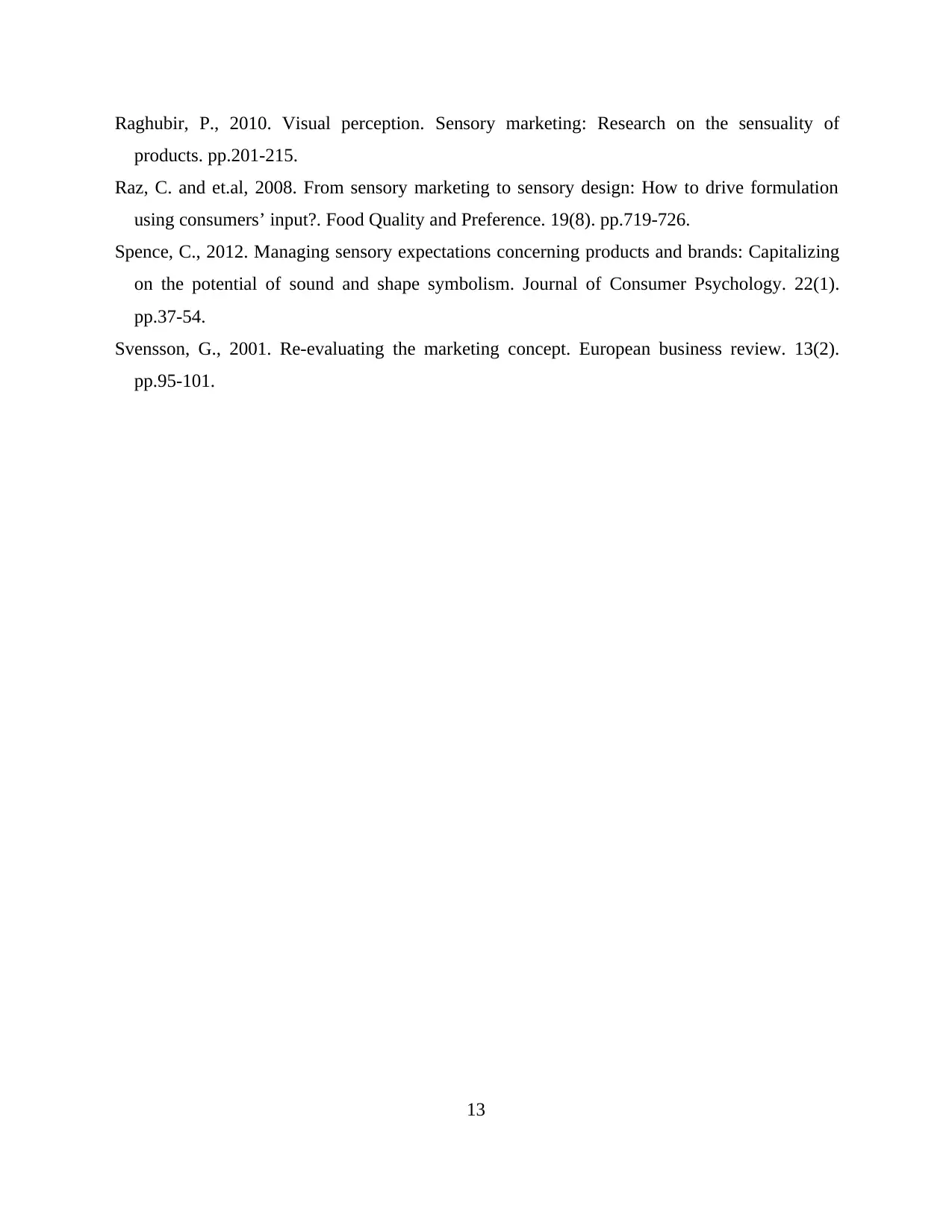
Raghubir, P., 2010. Visual perception. Sensory marketing: Research on the sensuality of
products. pp.201-215.
Raz, C. and et.al, 2008. From sensory marketing to sensory design: How to drive formulation
using consumers’ input?. Food Quality and Preference. 19(8). pp.719-726.
Spence, C., 2012. Managing sensory expectations concerning products and brands: Capitalizing
on the potential of sound and shape symbolism. Journal of Consumer Psychology. 22(1).
pp.37-54.
Svensson, G., 2001. Re-evaluating the marketing concept. European business review. 13(2).
pp.95-101.
13
products. pp.201-215.
Raz, C. and et.al, 2008. From sensory marketing to sensory design: How to drive formulation
using consumers’ input?. Food Quality and Preference. 19(8). pp.719-726.
Spence, C., 2012. Managing sensory expectations concerning products and brands: Capitalizing
on the potential of sound and shape symbolism. Journal of Consumer Psychology. 22(1).
pp.37-54.
Svensson, G., 2001. Re-evaluating the marketing concept. European business review. 13(2).
pp.95-101.
13
1 out of 13
Related Documents
Your All-in-One AI-Powered Toolkit for Academic Success.
+13062052269
info@desklib.com
Available 24*7 on WhatsApp / Email
![[object Object]](/_next/static/media/star-bottom.7253800d.svg)
Unlock your academic potential
© 2024 | Zucol Services PVT LTD | All rights reserved.




